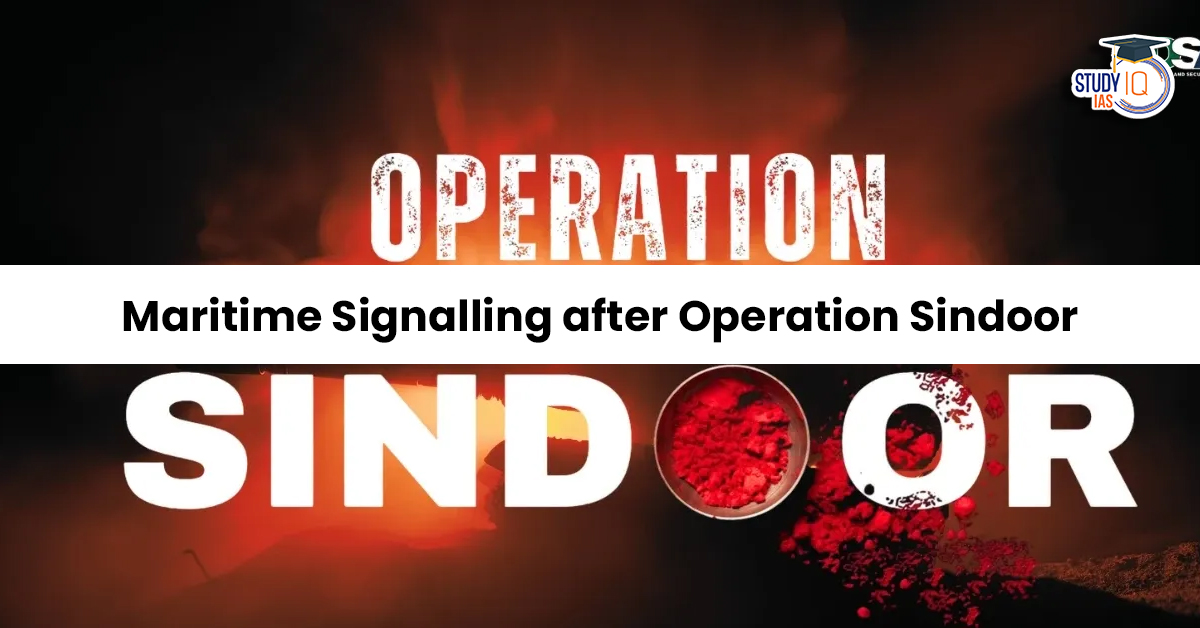Table of Contents
Operation Sindoor, which followed the May 2025 India-Pakistan standoff, has dramatically changed the geopolitical and military dynamics in South Asia. While the initial crisis unfolded in the air domain, subsequent developments have turned the spotlight toward the maritime theatre. Both India and Pakistan are recalibrating their naval postures, signaling readiness for potential escalation, and reshaping deterrence strategies in the Arabian Sea.
Background
The May 2025 standoff, resolved through limited air engagements, left behind a residue of strategic uncertainty. In its aftermath, both nations began demonstrating naval readiness through large-scale exercises, ship movements, and public statements.
On October 2, 2025, India’s Defence Minister Rajnath Singh issued a stern warning to Pakistan, citing the 1965 war and cautioning against any misadventure in the Sir Creek region — an area where Pakistan has been expanding military infrastructure since 2023.
This statement was followed by the Indian Navy’s visible assertion of a forward deterrent posture, signaling that the maritime dimension could define the next phase of India-Pakistan confrontation.
India’s Naval Readiness and Strategic Messaging
India’s approach after Operation Sindoor demonstrates a clear shift toward active maritime deterrence and regional capacity-building.
Key Developments:
-
Operation Sindoor was designed to ensure a forward deterrent posture for the Indian Navy.
-
INS Nistar, the first indigenously designed diving support vessel, was commissioned — highlighting India’s growing technological self-reliance.
-
India conducted its first joint naval patrol with the Philippines in the South China Sea, aligning with its Indo-Pacific strategy and signalling solidarity against China’s maritime assertiveness.
-
India’s Navy Chief, Admiral Dinesh Tripathi, emphasized that the Indian Navy would be the first to act in any future conflict with Pakistan.
These actions underscore India’s broader strategic vision — not only to deter Pakistan but to project influence across the Indo-Pacific maritime network.
Pakistan’s Maritime Response and Naval Expansion
Pakistan has also intensified its maritime posture, signaling readiness and deterrence in response to India’s moves.
Key Highlights:
-
Dispersal of assets from Karachi to Gwadar to reduce vulnerability from Indian strikes.
-
Launch of the Chinese-built Hangor-class submarine PNS Mangro, enhancing undersea warfare capability.
-
Test of the P282 ship-launched ballistic missile, showcasing indigenous advancement.
-
Conducting live-fire drills and missile tests, often within 60 nautical miles of Indian naval exercises — maintaining constant operational pressure.
Pakistan’s actions reflect a deterrence-by-denial strategy, aiming to prevent India from exercising its traditional maritime superiority, especially post-1971.
Strategic Implications: The New Deterrence Equation
The surge in naval signalling is more than routine posturing — it reflects a shifting deterrence equation in South Asia’s maritime theatre.
1. Escalation Control Challenges
Naval engagements are inherently riskier than air skirmishes. Any ship-on-ship confrontation could rapidly escalate into full-scale conflict. Pakistan’s memories of 1971 and India’s naval dominance make this domain particularly sensitive.
2. Chinese and Turkish Influence
China’s increasing presence in Karachi and Gwadar through the China-Pakistan Economic Corridor (CPEC) adds a new layer of complexity. The potential for People’s Liberation Army Navy (PLAN) involvement raises serious regional security concerns. Türkiye’s assistance in supplying Babur-class corvettes further strengthens Pakistan’s naval modernization.
3. Shrinking Strategic Gap
While India retains numerical and geographical advantages, its aging fleet and modernization delays have narrowed the dominance gap. Pakistan’s steady naval expansion and foreign collaborations have reduced India’s uncontested edge in the Arabian Sea.
External Dimensions and Regional Implications
The Indo-Pacific context adds another layer to this maritime signalling.
-
India’s joint patrols, stealth frigate inductions, and focus on indigenous technology reflect an effort to align with broader maritime partnerships like the Quad and ASEAN.
-
Conversely, Pakistan’s growing naval ties with China and Türkiye introduce external actors into the regional security matrix, complicating escalation control.
This externalization of the India-Pakistan maritime rivalry could transform the Indian Ocean from a bilateral conflict zone into a multi-actor strategic arena.
Future Outlook
The Indian Navy now faces a strategic dilemma — whether to use the maritime theatre for early crisis signalling or to keep it as a reserved escalation domain.
-
Increased joint drills, missile tests, and forward deployments point to a future where naval deterrence becomes central to India’s military strategy.
-
However, India must also balance deterrence with crisis stability to avoid unintended escalation, especially given the proximity of Chinese and Pakistani naval interests.
Conclusion
The maritime signalling after Operation Sindoor marks a new phase in India-Pakistan strategic relations. The Arabian Sea is no longer a peripheral front — it has become a testing ground for deterrence, capability, and psychological endurance.
As both nations expand their maritime capabilities, the risk of miscalculation grows — but so does the opportunity for mutual understanding through sustained naval interaction.
For India, maintaining maritime dominance while ensuring regional stability will define its strategic success in the coming decade.


 UN ESCAP Asia-Pacific Disaster Report 20...
UN ESCAP Asia-Pacific Disaster Report 20...
 Rare Hawfinch Sighting in Corbett Nation...
Rare Hawfinch Sighting in Corbett Nation...
 Bnei Menashe Community : The Lost Tribe ...
Bnei Menashe Community : The Lost Tribe ...

























